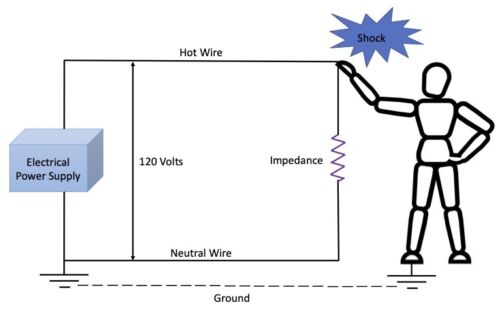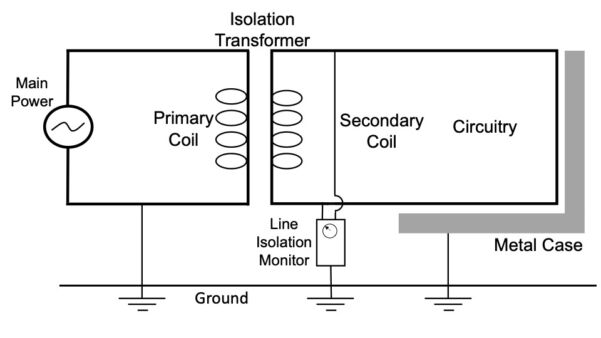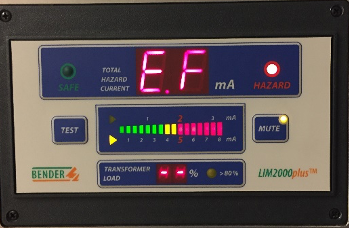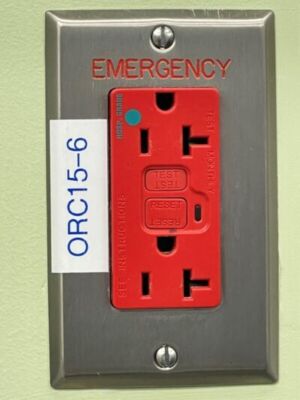Copy link
Electrical Safety in the Operating Room
Last updated: 01/04/2023
Key Points
- Patients should remain ungrounded in the operating room (OR) environment to decrease the risk of electrical shock and electrical burns.
- The isolation transformer converts a grounded power supply to an ungrounded (isolated) power supply.
- The line isolation monitor detects the potential for current to flow from the isolated power supply to ground.
- The ground fault circuit interrupter (GFCI) interrupts the power supply in a grounded power system when the threshold is exceeded.
- Macroshocks traverse intact skin while microshocks are applied directly to the heart.
Introduction
- The presence of multiple electronic devices combined with a potentially “wet” environment in the OR creates an electronically hazardous environment for both patients and faculty/staff.1-4
Isolation Transformer and Line Isolation Monitor
Isolation Transformer
- The power supply to homes and businesses is “grounded,” meaning that one wire supplying the power is “hot” and the other wire is “neutral” and connected to the earth.
- An electric shock occurs when the electrical circuit is completed through the body. Current flows across a voltage differential from the hot wire through the body, then to ground, thereby completing the electrical circuit (Figure 1).

Figure 1. Completed electrical circuit resulting in electrical shock
- In 2012, the National Fire Protection Association deemed all ORs as “wet” environments unless a risk assessment has been completed to categorize them as a “dry” environment.3,4 “Wet” environments require the installation of an isolation transformer and line isolation monitor.
- The isolation transformer converts the grounded power supply from the utility company into an ungrounded power supply for the OR. The primary coil of the isolation transformer is grounded, while the secondary coil has two live ungrounded lines for OR equipment (Figure 2).

Figure 2. Isolation transformer and line isolation monitor in OR
- When a person contacts a single wire from ungrounded circuitry, no shock occurs since the electrical circuit is not completed. A shock may occur if a person contacts both wires simultaneously, thereby completing the electrical circuit. Patients should remain ungrounded in the OR environment to decrease the risk of electrical shock and electrical burns.1-2
Line Isolation Monitor
- The line isolation monitor (LIM) checks the integrity of the isolated (ungrounded) power supply and measures the potential for the current to flow from the isolated power supply to the ground.
- The LIM alarms when the impendence to ground is less than 24,000 Ω or when high current flow (greater than 2 or 5 mA, depending on the LIM setting) becomes possible due to plugging in a faulty piece of equipment. Plugging in a faulty piece of equipment causes the first fault and connects the power supply to ground. The secondary coil or circuitry is now connected to ground, and a shock or electrical burn may occur if patients or personnel comes into contact.
- Electrical devices have leakage current. When the total leakage current of all devices in the OR exceeds 5 mA (newer LIMs) or 2 mA (older LIMs), the LIM will alarm (Figure 3; video).

Figure 3. Line isolation monitor displaying an electrical fault
- When the LIM alarms, immediately unplug the last piece of electrical equipment that was plugged in. If plugging that piece of equipment in again causes the LIM to alarm, remove that equipment from service. Otherwise, continue to unplug electrical equipment in the OR until the LIM stops alarming.
- If a vital piece of equipment (i.e., defibrillator, cardiopulmonary bypass) is causing the LIM to alarm, it may be safely used, recognizing that the protection of the isolated power system and LIM is no longer functional. Additionally, a fault in the wiring of the OR may cause the LIM to alarm.1-2
Ground Fault Circuit Interrupter
- Ground fault circuit interrupter (GFCI) prevents shocks from occurring in a grounded power system.
- The GFCI detects a difference in current flow between the hot and neutral wires and immediately interrupts the power supply. The GFCI detects as small as a 5mA difference.
- Pressing the “reset” button on the GFCI will reset the power supply if it was tripped by a power surge. If the GFCI cannot be reset, it was likely tripped by a faulty piece of electrical equipment. That equipment should be unplugged and checked.1-2

Figure 4. GFCI outlet demonstrating “Test” and “Reset” buttons
Macroshock
- Electrical shocks that traverse intact skin are called macroshocks.
- The minimum perceptible macroshock occurs with 1mA of current.
- Involuntary muscle contractions occur at 10 mA.
- Let-go current threshold is 10-20 mA (sustained muscular contraction, thereby preventing the person from letting go of an energized wire).
- Ventricular fibrillation occurs at 50-100 mA.1-2
Microshock
- Electrical shocks that are applied directly to the heart are called microshocks.
- Current as low as 50-100 µA applied directly to the heart may cause ventricular fibrillation.
- Risks: Devices in direct contact with the heart, including indwelling central venous catheters, transvenous pacing wires, and leakage current.
- Leakage current: All electrical power cords, wires, and electrical motors have some current that “leaks” to the ground.
- The maximum leakage current allowed in the OR is 10 µA, which is well below the threshold for the LIM and GFCI.1-2
References
- Ehrenwerth J. Electrical and Fire Safety. In: Clinical Anesthesia. 8th Ed. Paul G. Barash et al. Philadelphia: Lippincott Williams & Wilkins, 2017. pp.109-39.
- Salaman NE, Ju A. Hazards of the Operating Room. In: Manual of Clinical Anesthesiology. Ed. Larry Chu and Andrea Fuller. 2nd Ed. Philadelphia: Wolters Kluwer Health/Lippincott Williams & Wilkins, 2021. pp. 57-59.
- Barker SJ, Doyle J. Electrical safety in the operating room: dry versus wet. Anesth Analg. 2010;110(6): 1517-8. PubMed
Other References
- Cox B. Operating rooms as wet/dry locations risk assessment project. The Fire Protection Research Foundation. 2012. Accessed July 18th, 2022. Link
- Gibby GL, Lizdas DE, Lampotang S. Electrical Power and Safety in the Operating Room. University of Florida Department of Anesthesiology Virtual Anesthesia Machine Web site. 2013. Accessed July 18th, 2022. Link
Copyright Information

This work is licensed under a Creative Commons Attribution-NonCommercial-NoDerivatives 4.0 International License.